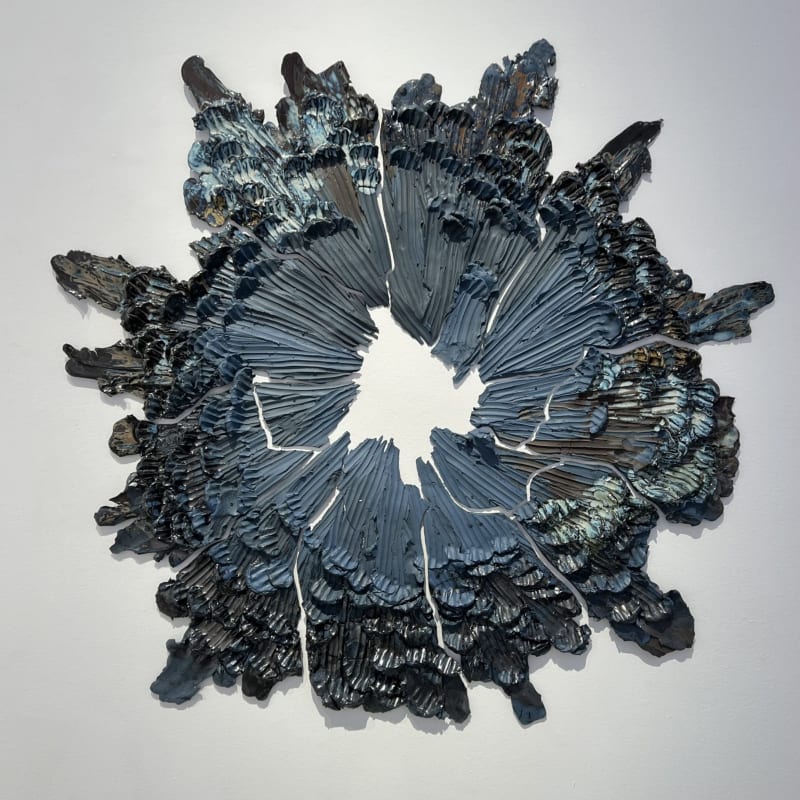with all the colors of the sky
forgotten by gravediggers
Use it
Use it to prove how the stars
were always what we knew
they were: the exit wounds
of every
misfired word
— Ocean Vuong
In her clay relief sculptures, Brie Ruais explores the exit wound and its deep psychological implications. For example, in “Exiting Wound, 130 Pounds of Clay,” there is a jagged hole at the center of the relief, with several lines radiating out. Ruais concretizes in clay Ocean Vuong’s metaphor. His 2016 book Night Sky with Exit Wounds suggests many of us bear the emotional equivalent of exit wounds from words fired and misfired our way.
The exit wound is created by Brie Ruais’s body, which is shown in the video “Digging in, Digging Out“, (2021) on view in the Albertz Benda gallery, as well as online on Vimeo. Her process involves pushing clay out from a center where she sits on the ground. She tears, scraps, spreads, to form ray-like forms with luscious textures and a blend of colors. Once this spreading is finished, she cuts the work into pieces and then fires them in a kiln. Her encounter with Vuong’s poem elucidated her attraction towards leaving a rough hole at the center to evoke a puncture.
As the artist explained to Hyperallergic, “What’s primarily in the show is a tearing … it’s like tearing a fillet of fish.” This aesthetic of tearing and the uneven gash further explore the wound as form.
Ruais varies the colors in this body of work. For example, in “Circling the Center and Falling off the Edge, 130 Pounds” (2021), there is a mix of turquoise, tan, green, brown and deeper hues. Two dimensional images cannot capture the sensuous physicality of the surface textures, or how these colors meld and fuse.
The number 130 pops up in most of her titles. This number refers to her own weight and her choice to work with 130 pounds of clay in making these sculptures. The heft of this weight, the ways she has to contend with it, engages her entire 130-pound body — both physiologically and psychologically.
“Letting the Fire In, 130 Pounds” (2021) was fired in a pit fire instead of a kiln. The unusual mix of black and white markings result from the entropic way that fire burned out the oxygen embedded in the clay. Fire’s unevenness has led most clay artists to prefer an electric kiln’s consistent heat, whereas Ruais celebrates the irregularities. Close up, the chaotic mists of black and white as well as the sundry burnt textures entice the eye.
As installed at the Albertz Benda gallery, “Letting the Fire In, 130 Pounds” features a literal exit wound ripped through the gallery wall. Its shards sit in a pile underneath the piece. It is possible to peer through the hole to see other parts of the show.
With the exhibition title, Some Things I Know About Being in a Body, Ruais alludes to the predicament of embodiment. Many philosophers and serious thinkers from Plato to Simone de Beauvoir has explored this. Ruais does as well, but physically, using her body to focus on how body work can release the emotional traumas that the tissues and muscles store. Ruais invites each visitor into a journey of physicality, of pushing and tearing at our own bodies to find a way to feel out and integrate the emotional wounds they might hold.

